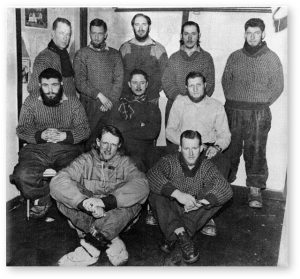 SANAE 1 team member, Marten du Preez (
SANAE 1 team member, Marten du Preez ( Radio Technician), passed away at the age of 96.
Radio Technician), passed away at the age of 96.
WAP conveys deepest condolences to his family and friends.
Marten du Preez (pic aside) was one of the members on the first overwintering team on Antarctica, SANAE I, as well as the team leader of SANAE 3.
WAP does not have any QSLs or even any callsigns used by operators at SANAE 1 and , SANAE 2 Bases. Any info will be extra appreciated!
TNX Gabry IK1NEG
1959 to 1962: Establishment of a permanent South African presence in Antarctica
On 1 December 1959 South Africa joined Countries like the USA, USSR, UK, Chile and Japan in signing the Antarctic Treaty.
South Africa established a permanent presence on the Antarctic continent in the 1959 to 1960 summer when the first South African National Antarctic Expedition (SANAE), a ten man party under the leadership of the veteran Hannes la Grange, took over Norway Station (WAP NOR-Ø7) at 70° 30′ South, 02° 52′ West, along with its 12 male husky sledge dogs.
 The picture on the left, taken by Andre le roux van der Merwe a medical doctor of the first South African Expedition (SANAE) to Antarctica shows the first South Africa’s Team at SANAE 1, 1960
The picture on the left, taken by Andre le roux van der Merwe a medical doctor of the first South African Expedition (SANAE) to Antarctica shows the first South Africa’s Team at SANAE 1, 1960
(Back: Andre van der Merwe, Dick Bonnema, Hannes la Grange, Marten du Preez, Blackie de Swardt. Middle: George Strauss, Niek Ersamus, Chris de Weerdt. Front: Victor von Brunn, Theo van Wyk)
All ten members of the expedition were employed by the South African Weather Bureau. The station was situated 35 km from the ice front at an altitude of 52 m.
Norway Station had been established for the International Geophysical Year in 1957 to 1958 with Sigurd Helle as leader at the time of transfer. The former Norwegian base (WAP NOR-Ø7) was only used for two years before SANAE I.
The South African expedition sailed south from Cape Town aboard the converted Norwegian sealer Polarbjom on 3 December 1959, reaching the continent, via Bouvetoya, at Polarsirkel Bukta on 8 January 1960. Veteran Allan Crawford was aboard as naval meteorologist. The voyage south was eventful: two members of the Polarbjorn’s crew died on the southern journey: a steward who fell overboard while emptying an ashtray over the side and the Second Mate, Reidulv Klein, who blew himself up in his cabin while preparing explosives. The latter was buried at sea in the pack-ice, with both Norwegian and South African flags at half mast. Later, the ship had difficulty progressing through the pack but the situation was solved by the timely arrival of the Argentine icebreaker General San Martin. Surface and upperair meteorological and geomagnetic observations, commenced by the Norwegians at the station in 1956. were taken over on 15 January 1960. Glaciological and geological fieldwork and bird observations, including finding breeding snow petrels (Pagodroma nivea), were also made during the first SANAE during a five-week field trip with huskies to several nunataks in the northern Ahlmannryggen by Hannes la Grange and Professor Victor on Brurm in November/ December 1960.
Since then a team of 14 men went there for 14 months at a time on a regular annual basis to study aspects like the weather, astrology, the magnetic field of the earth, cosmic rays and the ozone attenuation. The South African base used to be on the pack ice where it stretches more than 200 km into the sea, only 15 km from the spot where the sea and the ice meet. SANAE II was built in 1971 and SANAE III in 1979. Since then they have used a steel construction, necessitating a new base only every 13 years .
Thanks and credit SANAP: Sanae Teams – South African National Antarctic Programme (sanap.ac.za)
